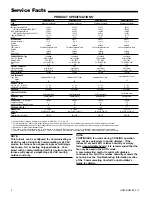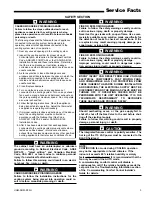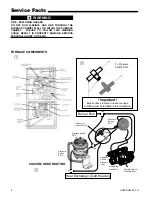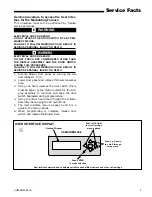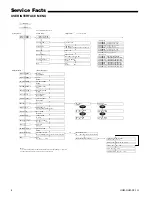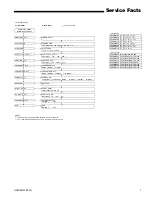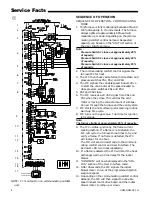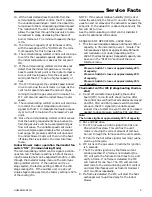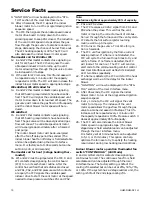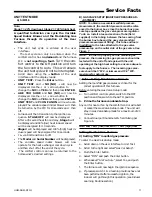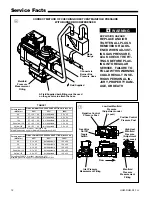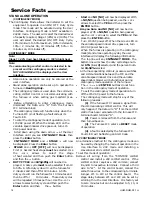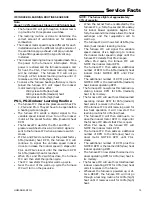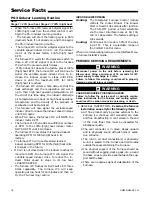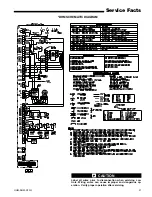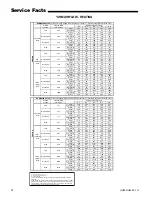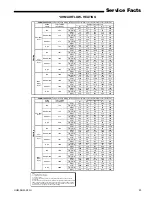
UHM-DHM-SF-1H
9
Service Facts
14. With a heat demand less than 65% from the
communicating comfort control, the IFC signals
the variable speed inducer motor drive board to
ramp down to that corresponding demand speed.
The reduction of the vent motor speed in steps
allows the gas flow through the gas valve to also
be reduced in steps, decreasing the chance of
burner flame out. The minimum capacity change
is 1%.
15. The minimum capacity of all furnaces is 40%,
with the exception of the *UHMD120. The mini-
mum capacity for this furnace is 45%.
16. The communicating comfort control will continue
to call for the requested capacity demand until
the indoor temperature is back at the set point
OR,
17. If the communicating comfort control does not
detect that the indoor temperature is moving
back towards its set point or the indoor tempera-
ture is still moving away from the set point, it
will signal the IFC to go to a higher capacity of
heat.
18. The IFC then signals the variable speed inducer
drive to ramp up the vent motor in steps. As the
vent motor speed increases the amount of gas
coming through the gas valve will increase. The
IFC will also increase the indoor blower motor
speed.
19. The communicating comfort control will continue
to monitor the indoor temperature and send
signals to the IFC to modulate the heating capac-
ity or turn off to maintain the homeowner's set
point.
20. Once the communicating comfort control senses
that the heating requirements have been satis-
fied, the gas valve will be de-energized and gas
flow will cease. The variable speed vent motor
will de-energize approximately after a 5 second
post purge. All pressure switches will open and
the indoor blower motor will then run the heat
off delay that is selected in the User Interface
menu.
Indoor Blower motor operation thermostat fan
switch “ON” (Communicating Mode)
The communicating comfort control signals a contin-
uous fan call. The factory setting is 50% of the cool-
ing cfm selected but can be adjusted from 25% - 100%
through the Installer Setup menu on the communi-
cating comfort control. If the outdoor unit is a 2
stage system, the factory setting is 50% of the 2nd
stage cooling cfm. If the outdoor unit is a 24 volt
single stage cooling system, the factory setting is 50%
of the cooling cfm.
NOTE: If the actual relative humidity (RH) is at or
below the set-point, the fan will run until the contin-
uous fan call is removed or the actual RH exceeds the
set-point. If the actual RH is above the set-point, the
fan will not turn on.
See the communicating comfort control Installer's
Guide for additional information.
SEQUENCE OF OPERATION – 24VAC Mode
1. This furnace modulates between 40% and 100% of
capacity, in 3% increments, every 1 minute. The
furnace always lights at approximately 65% and
will modulate up or down; depending on the
24VAC thermostat signal. Requested capacity can
be seen in the “STATUS” section of the User
Interface menu.
Note:
Pressure Switch 1 closes at approximately 40%
of capacity.
Pressure Switch 2 closes at approximately 65%
of capacity.
Pressure Switch 3 closes at approximately 95%
of capacity.
Thermostat call for W1 (2 stage heating thermo-
stat)
2. R and W1 contacts close signaling the control
board (IFC) to run its self- check routine. After
the control has verified that all safeties are closed
and PS1, PS2, and PS3 pressure switch contacts
are open, the IFC signals the variable speed
inducer drive to start the vent motor at the speed
needed to close pressure switches PS1 and PS2.
Note:
The furnace lights at approximately 65% of capacity
.
3. PS1 and PS2 close.
4. The IFC receives a 24 VAC signal from PS1 and
PS2 when they close. This verifies the vent
motor is moving the correct amount of combus-
tion air through the furnace and the vent system.
5. IFC starts the hot surface ignitor learning routine
warm-up time cycle.
6. IFC turns on the gas valve. Trial time for ignition
is 5 seconds.
7. The IFC verifies ignition by the flame current
sensing method. If a flame is not detected, the
IFC will cycle the furnace three times to try and
verify a flame. If no flame is detected, the IFC
will lockout for one hour. The IFC will send an
alert code to the communicating comfort control
and User Interface as well as flash its Red alert
LED two times repeatedly.
8. If a flame is detected, the IFC will start the heat
exchanger warm-up time delay for the indoor
blower.
Summary of Contents for ADHMB060BCV3VA
Page 37: ...UHM DHM SF 1H 37 Service Facts...
Page 39: ...UHM DHM SF 1H 39 Service Facts...
Page 41: ...UHM DHM SF 1H 41 Service Facts...
Page 47: ...UHM DHM SF 1H 47 Service Facts...
Page 49: ...UHM DHM SF 1H 49 Service Facts...
Page 51: ...UHM DHM SF 1H 51 Service Facts...


